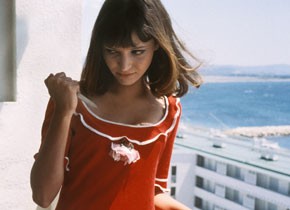Jean-Luc Godard
The First Wave
March 12 to April 9, 2015
"Art is not a reflection of reality. It is the reality of that reflection."
The initials JLG are synonymous with an entire ocean of cinema. Its "first wave" – 15 feature films made over a period of only eight years, plus numerous shorts – marks the beginning of a multi-part presentation of Jean Luc Godard's work at the Austrian Film Museum, continuing up until 2017. Part 1 of this project is dedicated to Godard's epochal redistribution of the cinematic senses during the early and mid-1960s, his moment at the center of global artistic production. As Bernardo Bertolucci has stated, "There was cinema before Godard and cinema after – like before and after Christ." Or, in less religious terms: Godard's significance to his own and neighboring disciplines in the second half of the 20th century can only be compared to that of Andy Warhol and Bob Dylan.
With his first feature, À bout de souffle (1960), starring Jean-Paul Belmondo and Jean Seberg, Godard was already exploding convention. "Modern cinema is unthinkable without this work," writes Amos Vogel about Godard's debut, which thoroughly changed the concept of how movies are supposed to look. Literally breathless, with its disorienting jump cuts and frenetic camerawork, it announced the arrival of an attitude to life and cinema – to cinema as a way of life – that would always try to be one step ahead of the general modernization of this era. The soothing order of classical and realist film narrative and the common contract between characters and the audience lose much of their validity here; the protagonists regularly break the walls of fiction (for Godard, À bout de souffle was "a documentary about Belmondo and Seberg") and ask to be deciphered – just like characters in real life. At the same time, following his love of paradox and dialectics, Godard offered a self-conscious collage of quotations which emphasized the "constructed" nature of the film as well as its shocking stylistic innovations.
While these innovations were rapidly absorbed by others, their author developed at a speed faster than light. In Le Petit soldat (1960, banned in France due to its Algerian war theme), Godard subjected the soundtrack to manoeuvers as radical as his visual strategies in the previous film. In 1961/62, using color and wide-screen for the first time, he presented "the idea of a musical" (Une femme est une femme) and applied the ideas of Brecht to a spare passion play on prostitution (Vivre sa vie). 1963 saw another “double” of seemingly contradictory works: Les Carabiniers, a deconstructed war film in the spirit of his idol, Roberto Rossellini, and the sublime Le Mépris, featuring a superstar, Brigitte Bardot. Within that film, another Godard role model, Fritz Lang, directs an adaptation of the Odyssey, providing a significant example of the irreverent and erudite fusion of high and pop culture that Godard celebrated during these years. When Alphaville and Pierrot le Fou arrived as instant classics in 1965, he himself had become a role model: the epitome of a new idea of the filmmaker as pop-intellectual – and the filmmaker's filmmaker par excellence, a deep influence on directors ranging from Chantal Akerman to Quentin Tarantino.
Godard, born in 1930, grew up on Lake Geneva in a French-Swiss upper-middle class family, moved to Paris in 1948 and there encountered other film enthusiasts like Claude Chabrol, Jacques Rivette, François Truffaut and Eric Rohmer. Within a few years, as regular visitors to the Cinémathèque française and as critics for Cahiers du cinéma, they established the politique des auteurs and laid the groundwork for their own directing ambitions. Amongst this group, however, Godard stood apart. His cinema was not only trendy and modern, but also genuinely essayistic. As a director he would continue to be a film critic: reflecting on movies as something independent, between art and life; communicating this special something through polyphonic soundtracks and dazzling images, discursive rhythms and syncopated montage; and embellishing this discourse with masterful aphorisms like "The cinema is truth 24 times a second."
The difference between the concepts and the perception of reality increasingly became the center of Godard's reflections: 2 ou 3 choses que je sais d'elle (1967), the summation of his early work as a feature filmmaker, is also an anthology of documentary methods, in which words and images regularly clash. In Godard's whispered commentary, we hear the doubts of a passionate manipulator of language who understands that speech too often produces only misunderstanding. That same year, Week End concludes the “first wave” of JLG in an appropriately apocalyptic fashion – and with a declaration: fin du cinéma. This is not a farewell, however, but a line drawn to demarcate the end of Godard's time in the popular spotlight, to be followed by a polemical phase (as a declared Maoist) and numerous waves of further self-reinvention.
The retrospective, supported by the Institut français, presents all films made by Jean-Luc Godard up until 1967, including his rare shorts, episodes, and collaborative works from this period.


